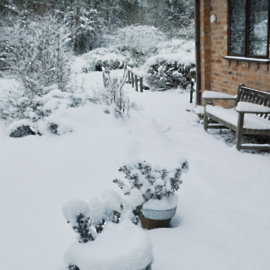Just because the cold weather has descended it doesn't mean we should be forgetting to look after our gardens, in fact it's essential to keep them ticking over in the winter months.

Home and Garden on Female First
Gardening expert, Charlie Dimmock - who you may remember from round Forcer - shares some expert tips on how to look after your garden in the winter.
Plant spring bulbs like crocus, tulips and daffodils in borders and containers, drifts of daffodils looks fantastic naturalised along hedge lines or under trees. When planting make sure the bulbs are planted to the right depth, as a general rule it is three times the depth of the bulb and if your soil is heavy, dig in some coarse grit at the bottom of the hole to stop water logging.
 Tidy borders by cutting back herbaceous plants, removing summer bedding and weeds. Lightly fork over and mulch with well-rotted garden compost or mushroom compost.
Tidy borders by cutting back herbaceous plants, removing summer bedding and weeds. Lightly fork over and mulch with well-rotted garden compost or mushroom compost.
Autumn and early winter is a great time to plant new shrubs and trees as they establish and root down well because the soil is warm from the summer and moist from the autumn rain, which means they get a really good start in the spring.
Lift and store/pot-up smaller, non-hardy plants like dahlias and geraniums while with larger plants that can’t be moved like tree ferns and Gunnera protect with their leaves or wrap in hessian or, if in containers, move them close to the house for extra protection.
Plant winter bedding such as pansies, wall flowers and forget-me-nots for lots of much appreciated colour in winter and early spring. Plant them in key places that can be seen from indoors and it is best to put the plants closer together than normal as they don’t fill out as much as summer bedding.
Rake up leaves regularly especially from the lawn as if left it can lead to bare patches. It is well worth composting the leaves separately to make wonderful leaf mould which is great for top dressing rhododendrons and lily bulbs or using when planting those special plants. If the leaves are dry make life easier by using the mower to collect them.
On wet days tackle the shed and greenhouse, clean up tools, re-sharpen blades, generally tidy up and sort things out. Also, go through seed catalogues selecting what you are going to grow for the following year that way you are all set up and ready for the spring rush.
Clear and tidy the veggie patch, throwing out any canes and netting that is past its sell by date. Roughly dig over the soil but you don’t need to worry about breaking up the clods as the winter weather will naturally do that for you.
Feeding the birds in winter adds lots of interest to the garden as well as helping the birds out during our cold weather. If you are going to use feeders that you already have, make sure they are clean and always have water available for the birds to bathe and drink from. This is especially important in cold, frosty weather.
Cut back ponds and cover with netting that will need to be supported to stop the worst of the leaf fall going in and rotting. If there is a pump in the pond I leave it in but raise it up. This way the pond stays warmer and also keeps a hole in the ice. However, if you want to remove it, make sure you store it clean and dry in a frost-free place.
Charlie is working with Horlicks to launch the new look pack, still with the same great taste.
Tagged in Garden Home & Garden

